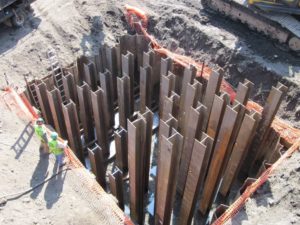Concrete piles vs steel piles
 The pile is a long cylinder made of a strong material such as steel or concrete. The pile is pushed into the ground so as to offer a steady support and foundation for the structures built on top. The foundations made of the pile are required when the surface soil is a weak layer and is not able to support the weight of the building. Loads of the building need a stronger support, and their weight needs to be transferred to the layer of stronger rock lying below the weak layer. The building above may be carrying heavy concentrated loads such as a water tank or a bridge.
The pile is a long cylinder made of a strong material such as steel or concrete. The pile is pushed into the ground so as to offer a steady support and foundation for the structures built on top. The foundations made of the pile are required when the surface soil is a weak layer and is not able to support the weight of the building. Loads of the building need a stronger support, and their weight needs to be transferred to the layer of stronger rock lying below the weak layer. The building above may be carrying heavy concentrated loads such as a water tank or a bridge.
There are different material used for making pile such as timber, steel, concrete and composite piles. As wood is economically priced, it is used for the manufacture of temporary piles. Concrete is used for making pre-cast concrete piles, pre-stressed concrete and cast in place piles. Steele materiel is sued for malign both permanent and temporary works. The purpose behind these piles is to transfer the load on to a firm rock bed transfer.
Concrete piles vs steel piles
Concrete piles
There are two kinds of concrete piles, pre-cast and cast in place concrete piles. Pre- cast concrete Piles are made and reinforced by high-quality controlled concrete. These piles are usually used for square, circular, triangular or octagonal section. Made in short length of about a meter and with intervals of three and thirteen meters, they can be easily connected together to reach the desired length. However, reinforcement is essential within the pile to withstand handling and driving pressures. Pre stressed concrete piles are fast becoming popular. As for the Cast in place concrete piles, they are commonly used for foundations. They are available in great diversity for appropriate introduction of the pile into the soil and when pouring concrete. The two types of cast in place concrete piles are the driving and drilling piles.
Steel Piles
Steel Piles carry relatively small cross-sectional area and are suitable for handling and driving in long lengths. Their higher strength makes it easier to penetrate the firm soil. It is easy to cut them off or join with the help of welding. There might be some risk to the steel pile if driven into a soil with low pH value. However, those risks are very small. One can always employ cathodic or coating protection in permanent works. The corrosion process can be prolonged by more than fifty years by simply over dimensioning the cross-sectional area of the steel pile.
Concrete piles are relatively inexpensive and easy to splice. They can be driven in long lengths and remain stable. However, cast-in-place concrete piles can be installed in very large diameters. Still, concrete cannot be subsequently inspected and cannot be extended above ground level, especially in marine structures. When it comes to the steel piles, they are easy to handle and can be driven through compact layers and in very long lengths. Those piles can carry heavy loads but are relatively expensive and will corrode with time.




